Rethinking Research Libraries in the Era of Global Universities
As our world becomes increasingly interconnected politically, economically, culturally, and socially, higher education has followed suit. The 2011 survey by the American Council of Education’s Center for Internationalization and Global Engagement found a perceived acceleration of internationalization across campuses, from doctoral to associate degree institutions.[1] The definition of what that means for each institution varies. Graham Elkin, Faiyaz Devjee, and John Farnsworth developed a 13-scale model to assist universities in evaluating where they are presently and where they could further develop (see fig. 1).[2] How our universities characterize their current and aspirational states shapes the environment in which research libraries can advance their efforts.
Fig. 1. Framework of Internationalization[3]

This article addresses how research libraries can explore unmet needs and identify new opportunities for engaging deeply in the evolving teaching, learning, and research life of a global university, with primary attention given to students. Since the role of research libraries in acquiring and preserving international collections is a well-defined practice, the authors will focus on other, less-developed aspects of engagement.
Building Universities as Global Entities
Although U.S. universities have had international ties for a century or more, the past two decades have seen a dramatic rise in global engagement. American higher education has extended its presence around the world by establishing international programs and more recently whole campuses abroad, by courting more international students, and by internationalizing the curriculum and the American student experience. The number of American students studying abroad and the number of international students coming to the U.S. are at an all-time high. Study abroad programs have risen significantly since 2000, with over 300,000 American students studying abroad for academic credit in 2013/14 (see fig. 2).[4]
Fig. 2. U.S. Study Abroad Students 1989/90-2013/14[5]
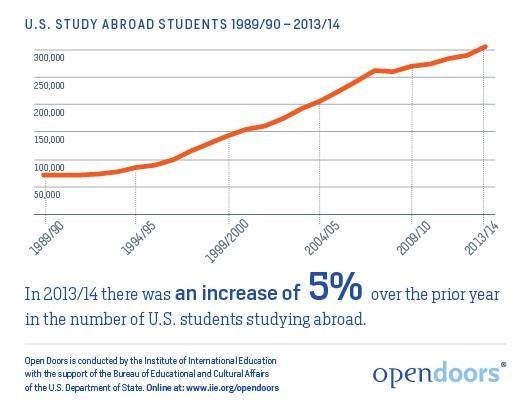
In 2014, the Institute for International Education launched a five-year national campaign to double the number of students studying abroad by decade’s end, from 10% to 20% of all college students. As of May 2016, 400 U.S. colleges and universities had joined the Generation Study Abroad campaign, including 55 members of the Association of Research Libraries (ARL).[6] By comparison, the number of international students coming to the U.S. to study is much larger than the number of American students studying abroad and has risen more sharply. In 2014/15 the number approached one million (see fig. 3).[7]
Fig. 3.[8]
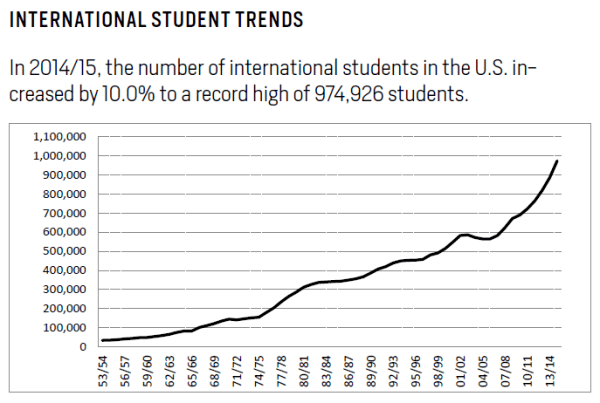
Assessing Library Support for Internationalization
For years, research libraries have responded to their institution’s international interests by curating collections from around the world. These collections serve novice language learners, native-speakers seeking collections from their homelands, and scholars conducting deep research in the world area of their expertise. A 2008 survey from ARL on library support for study abroad revealed that all of the 53 library respondents provided access to online resources to those students. Among others, the University of Minnesota Libraries and Cornell University Library implemented proxy bookmarklets to facilitate access remotely.[9] Several dozen libraries offer document delivery and reference services.[10] Some, such as Northwestern University Library, also send physical books to faculty and students in study abroad programs.[11] Steven Witt’s research provides a glimpse into additional services and their distribution across institution types (see fig. 4), with “Guides” in the aggregate being the most frequently cited service.[12]
Fig. 4.[13]

Library introductory sessions and tours tailored for international students are often provided as a part of a university’s orientation program. Typically these sessions focus on how American research libraries work and often take place before classes start, amidst a highly stressful period when international students are receiving crash courses on immigration regulations, housing, banking, health care, transportation, etc.[14] Once the semester starts, libraries gradually return to established routines. They utilize technology, such as videos and LibGuides, to keep the information alive and meet international students in instruction sessions and at the reference desk.
Many universities are ramping up their international agendas both in number and variety and this acceleration requires a deeper commitment from research libraries to support. More institutions are opening branch campuses overseas as part of their internationalization strategy and in response to the growing demand for higher education across the globe as well as to increase revenue. Indeed, the Education Advisory Board reported in 2015 that 76% of the international students in the U.S. are self-pay or are funded by their government, creating an estimated $21 billion annual contribution to the U.S. economy.[15] The U.S. leads the world in establishing international branch campuses. According to the Cross-Border Education Research Team (C-BERT) at the State University of New York at Albany, there are 52 U.S. institutions supporting 82 branch campuses, with more in the planning stages.[16] New York University is one of the more notable, with academic centers on six different continents, the most recent of which is NYU-Shanghai.[17] Others are establishing collaborative degree programs, most frequently in business, such as the Duke and Seoul National University (SNU) one that allows students enrolled in Seoul National University’s Global MBA program (GMBA) or MBA program (SMBA) to undertake a year of study at Duke.[18] Many more institutions offer credit-bearing online programs and classes to overseas students.
The increased internationalization of research and learning disrupts traditional education models. New services, connections, and expertise are required to support the needs of mobile faculty and students. Within the library, internationalization calls into question standard organizational structures that pivot around collections. Traditionally research libraries have built collections in response to university programs on campus. Subject librarians and curators function as agents who speak on behalf of the programs when assembling the collections, and speak for the collections when supporting teaching and research. Typically, the staff are hired proportionately to the size of the collections acquired, less by the numbers or types of users that are supported. This model is most pronounced in area studies, where language and cultural expertise are critical. This model continues to hold value but it is insufficient to the ambitions of today’s global universities.
It is our contention that the internationalization of American universities can best be served by realigning research libraries towards an engagement-centered structure. Having a strong East Asia collection or curator, for examples, does not automatically make the library a strong partner for a dual-degree MBA program in China, nor does it make a Chinese student studying engineering at a U.S. institution more successful. Nor does a strong business librarian or an engineering librarian necessarily guarantee effective outreach to Chinese students—the largest international student population on many campuses today. A joint team pairing disciplinary expertise and language/cultural knowledge can make a significant difference in the success of those MBA or engineering students. Research libraries need to fundamentally rethink structures and roles in the context of the global university. In doing so, they not only can leverage existing strengths but expand opportunities to become more deeply integrated in the work of their parent institutions.
With record numbers of international students on campus, U.S. colleges and universities are placing greater emphasis on helping students thrive. A 2010 study by C. K. Kwai, on international student retention after the first year in two statewide systems, identified three factors predictive of success: spring semester GPA, number of credit hours attempted, and on-campus employment.[19] These three factors may suggest opportunities for libraries in designing intervention strategies to assist international students.
David Di Maria, director of international programs and services at Kent State University, conducted a 2012 study on campus services for international students. He developed the following formula for increasing retention levels:[20]
International students’ retention = Early identification of potential for failure + Identification of (universal + immigration-specific + culture-specific + individual) needs + (early, intensive and continuous) Interventions.
Di Maria interviewed staff members in such units as residence life, student counseling, and career services. The majority of those interviewed reported that they were often ill prepared to meet the needs of international students, did not offer specialized services for them, and felt inadequately trained to do so. “The biggest challenge,” opined one of his interviewees, “is that we don’t talk about it very much. And because we don’t talk about it very much, we don’t intentionally address that segment of our population.” Noting that campus service for international students most squarely falls on the international student office, Di Maria argued that other campus services need to work closely together to share the responsibility.[21] The units studied by Di Maria are on the administrative side of the house. Academic units, such as libraries, have much to offer as part of a collective institutional network for international students.
Engaging International Students Directly
To remain relevant in a global university, research libraries need to shift from a supporting role to a participating one. This means moving beyond assembling world area collections, waiting for students to come to the library or locate LibGuides, ensuring access to resources, providing one-shot send-off or welcome orientations, and offering instruction sessions that do not differentiate between domestic and international students’ needs. Engagement requires seeking out international students, identifying needs specific to them, and addressing their pain points. Below we discuss some approaches for moving from the periphery to the center of international students’ experience.
Understand International Student Assumptions and Norms
International students—whether they come to the U.S. to study or are American students studying abroad—face considerable challenges not experienced by domestic students. Even when language is not a barrier, they face social isolation (see fig. 5) that can prevent them from moving beyond preconceived notions of how to succeed academically. These cultural assumptions can affect how well they will adapt to a country’s higher education standards and norms. This extends to their use of libraries.
Fig. 5. International Students Feel disconnected from Campus and Peers[22]
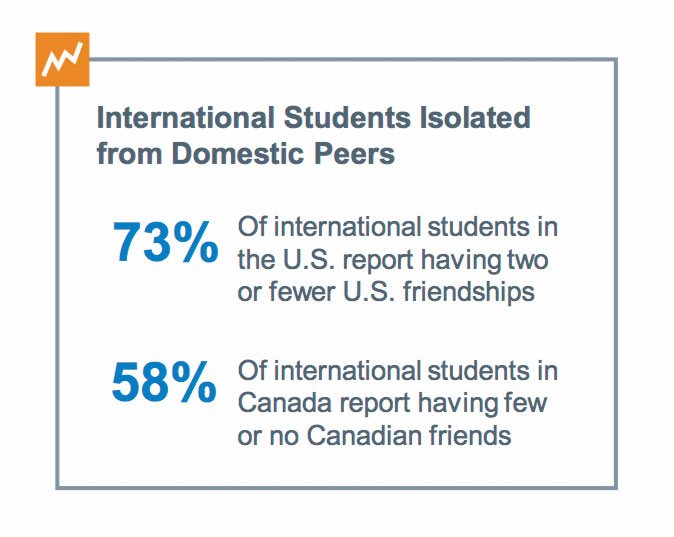 Outbound study abroad students and inbound international students alike bring with them individual baselines that are shaped by their prior library experience at home. Such experiences will differ country to country. Student perception findings, from studies such as the ones conducted by Ilka Datig with NYU’s Abu Dhabi students[23] and Shuqin Jiao[24] with international students studying in China, are good illustrations. For example, Datig found that Abu Dhabi students perceive librarians as organizers of books and as such view their knowledge as limited to familiarity with the physical library. Jiao found that international students experience language barriers and different concepts of services, such as reserves, in Chinese academic libraries. Conversely, some international students unfamiliar with the American academic standard regarding plagiarism are surprised to learn that copying someone else’s work is considered cheating but asking a reference librarian for help is not. On the technology front, some libraries abroad are ahead of their American counterparts. For example, a library delegation from the Sungkyunkwan University of South Korea presented at Cornell technologies in use in its library, from digital lockers to high-tech presentation rooms, to touch screen newspaper readers. None of these is currently available at Cornell Library. Such prior experience, too, shapes the expectation of inbound students. These examples point to how cultural baselines can influence assumptions and student success. Libraries should think “outside-in” and begin with international student perceptions in developing programs to meet their needs.
Outbound study abroad students and inbound international students alike bring with them individual baselines that are shaped by their prior library experience at home. Such experiences will differ country to country. Student perception findings, from studies such as the ones conducted by Ilka Datig with NYU’s Abu Dhabi students[23] and Shuqin Jiao[24] with international students studying in China, are good illustrations. For example, Datig found that Abu Dhabi students perceive librarians as organizers of books and as such view their knowledge as limited to familiarity with the physical library. Jiao found that international students experience language barriers and different concepts of services, such as reserves, in Chinese academic libraries. Conversely, some international students unfamiliar with the American academic standard regarding plagiarism are surprised to learn that copying someone else’s work is considered cheating but asking a reference librarian for help is not. On the technology front, some libraries abroad are ahead of their American counterparts. For example, a library delegation from the Sungkyunkwan University of South Korea presented at Cornell technologies in use in its library, from digital lockers to high-tech presentation rooms, to touch screen newspaper readers. None of these is currently available at Cornell Library. Such prior experience, too, shapes the expectation of inbound students. These examples point to how cultural baselines can influence assumptions and student success. Libraries should think “outside-in” and begin with international student perceptions in developing programs to meet their needs.
Research libraries currently help bridge these experiential and cultural divides by providing a neutral academic space on campus where students can stay in touch with home by accessing newspapers in their native language, where they can meet people from their own countries, connect with students across the disciplines, and where they can gain valuable information on academic norms and expectations. Many libraries, such as Kent State, host welcome receptions so that international students can get to know resource librarians and gain an overview of library services and resources.
Librarians can do more to engage international students’ concerns and assumptions as they struggle to acclimate. Holding library receptions for students from a particular country, for example, where they are greeted by librarians and faculty who speak their native languages, can make those students feel more comfortable, especially in their early adjustment period. Meeting Chinese graduate students and visiting scholars in graduate student housing facilities helped Cornell librarians understand how prevalent Chinese social media platforms, such as WeChat and QQ, remain for those studying abroad and pointed to the value of engaging in their online space rather than U.S.-centric ones. Librarian John Hickok from California State University, Fullerton, devoted his sabbatical to visiting libraries in East and Southeast Asia to understand students’ experience in their native environments. This work provided him with an appreciation of cultural differences that helped shape strategies for instruction and outreach back home.[25]
Lobby for Closer Collaboration on Campus
As noted above, mutual benefits can be gained from collaboration between academic and administrative units on campus that intersect with international students. Libraries should actively reach out to offices such as Study Abroad, the International Students and Scholars Office (ISSO), Student Support Services, Housing and Dining, but also to academic units, including Institutional Research and Planning as well as offices in colleges or departments with significant numbers of international programs or international faculty and students. Each of these units offers data and direct experience with the populations they serve in their areas of responsibility. The University of Cincinnati has developed UCosmic, an online system to document the ways in which faculty, staff, and students are connected internationally. Included is data on UC’s international collaborations and agreements, international student organizations and activities, demographic data on international students and international alumni, and contact and profile information of regional companies with an international focus and some form of UC connection.[26] Such information can provide an entry point for libraries to investigate the information and service needs associated with a particular region or discipline or formal agreement.
The library can take the lead in developing a more coherent approach to supporting international students (and faculty) through the establishment of a formalized network that facilitates smooth information flow, that highlights specialized knowledge and skills within the community, and that provides a mechanism to utilize resources optimally. Research libraries can serve as an ideal catalyst for such development, given their campus-wide responsibilities, their resources (including language expertise and locations), their reputations as trustworthy, and their bridging role between the administrative and academic sides of the house. In a very real sense, the library serves as the living room of the campus where service providers, faculty, and students congregate, and where problems and solutions can meet.
International student advisors will be key to developing such a network. They have direct and considerable knowledge about not just the academic aspects but also the challenges of living in the U.S. that international students and faculty face, from language to academic concerns to isolation and discrimination problems.[27] At Cornell, for example, we have begun to host an annual information exchange event at which the ISSO staff come to share with the library staff what they do and how they do it. A highlight of the exchange is hearing from a panel of international students at different academic stages who describe their challenges and how they overcame them. A law student from Ghana shared his story about how frantically he looked for a physical blackboard upon his arrival, because he was told that the syllabus was on it, only to learn later that the faculty and his fellow classmates were referring to the course management system, Blackboard. Such barriers would not necessarily surface through user surveys or instruction sessions, nor would they be known to relevant campus units that can help. The University of Houston Library has collaborated with Learning Support Services to promote a small set of readings, such as Getting Ahead as an International Student (Open University Press, 2009) and Writing for Engineers (Palgrave Macmillan, 2005), to help underrepresented and nontraditional students acclimate.[28] This model can be adapted to address even finer slices of needs among international students.
The development of campus networks can highlight services that may be in place but are unknown to their intended audience. For instance, Kayo Denda of Rutgers University Library determined that study abroad students and faculty were not aware that library privileges continue remotely.[29] Similar communication challenges are all too common. This year Cornell Library turned to the study abroad program for help in marketing its services. Library staff shared design ideas for promotional materials with the program’s staff, asking them to pick the option that would be most effective in reaching students. Their pick was a peelable sticker that can be put on suitcases, laptops, and other travel items (see fig. 6). Visually appealing, the sticker includes the URL for the Library’s Study Abroad LibGuide. Not only did this collaboration make the library’s final product better, the information will support the study abroad staff on trips overseas, and helped turn them into promotional allies.
Fig. 6. 2016 Cornell University Library Study Abroad Service Promotional Stickers
 Design and photo by Carla DeMello
Design and photo by Carla DeMello
Embrace Internationalization as a Whole Library Responsibility
The engagement-centered research library must develop the mindset that supporting the internationalization of the university and the distinct needs of study abroad and international students is the business of the entire library. International students shouldn’t be viewed as the exception but rather integral to the whole library’s efforts. Internally, libraries need to rethink how their individual parts interact with each other to maximize effectiveness in meeting current and upcoming needs, in building university awareness of the library’s capabilities, and in finding the “white space” where services and expertise can increase the academy’s effectiveness in advancing its agenda.
In large research libraries, curators and area studies librarians have served as the library’s front line in acclimating international students and faculty across disciplines to the campus, often thanks to their language skills. They may be ill-equipped, however, to respond to the specific disciplinary needs of international students and faculty and may be unfamiliar with what the library’s subject liaisons can provide. Subject liaisons, on the other hand, typically lack the cultural knowledge or language skills to support international students to the fullest by themselves.
According to the Institute of International Education, the majority of international students come to American colleges and universities to study in the STEM disciplines and business/management (see fig. 7).[30] Individual universities collect such data specific to their own circumstances. For example, of the more than three hundred Korean students at Cornell—the third largest international student population—almost half are in three colleges: Engineering, Law, and Arts and Sciences. Curators, area studies librarians, and subject liaisons can use this drill-down data to develop a collaborative strategy to meet specific cultural and disciplinary needs.
Fig. 7. Fields of Study of International Students[31]
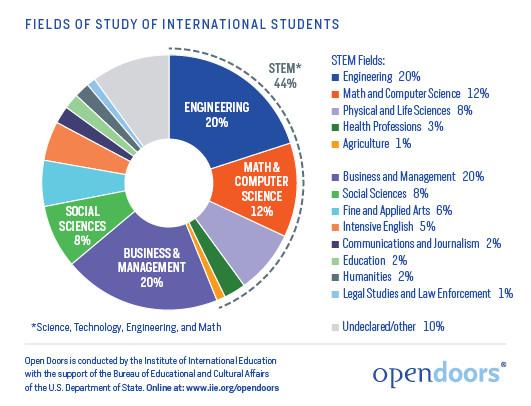
American students studying abroad can differ significantly from their in-bound counterparts in their chosen fields of study. The Cornell tracking data for study abroad (see fig. 8) will not be representative for other universities on a departmental/major level but such data is collected by each university and should be used to inform the library’s strategy for supporting students studying abroad. It is important to know where students are going but also what they are studying. Library liaisons can use such data to seek college and department-level answers to questions such as why animal science undergraduates are the number three participants in Cornell’s study abroad programs? Where do they go? What do they do? Is there a need for library support and how is it met? In turn, curators and areas study librarians should be brought in to consult with subject liaisons in building awareness of cultural and political obstacles the students may face. They may reach out to library peers at the respective destination universities to build support service there.
Fig. 8. Top Undergraduate Majors of Participants, “Cornell Student Experiences Abroad, 2013-2014”[32]
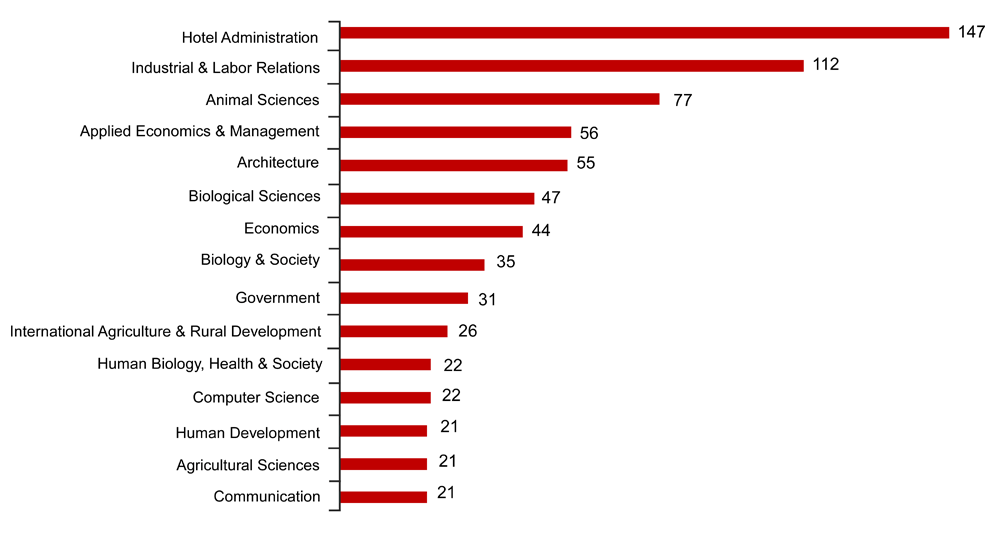
Going forward, close collaboration between the curators/area studies librarians and library liaisons can significantly enhance the level of student experience. Additionally, other library staff resources can be better utilized. For instance, technical services acquires and makes collections from around the global findable through cataloging and represents a large pool of language expertise. Cornell technical services staff catalogs materials in close to 50 languages. More than a dozen of the staff members speak foreign languages proficiently. They are included on a contact list of language experts, published on the library staff website, ready to be on-call to facilitate communication between library staff and international students and faculty. Tapping the full range of staff expertise helps the library present a coherent view of its capabilities to the international community, whether they are on campus or abroad.
Build the Global Village
John Wilkin, among others, has written about the critical importance of leveraging the work of others, which involves “the consolidation of efforts in a sphere that cuts across institutions, for example through geographic, peer, or even broader alliances.” “By using scale-enhanced strategies,” he reasons, “we shift resources and methods to a larger collaborative space. This is especially helpful in areas where the shift creates efficiencies, improves the service, or both, without changing the fundamental nature of the work.”[33] We believe that research libraries will not be able to support fully the internationalization aspirations of their parent institutions until they embrace, build, and sustain a global engagement network.
Beginning steps towards this model centered on international digitization efforts. The Discovering Modern China project supported by the Council on Library and Information Resources and led by the University of Washington and the University of British Columbia Libraries is a prime example,[34] as is the Joint Digital Library for Overseas Chinese Studies by the World Confederation of Institutes and Libraries for Chinese Overseas Studies.[35] Such efforts may ease access but not necessarily discovery as the metadata for finding the resources are not aggregated at a higher level. Going forward, research libraries need to move beyond individual portals to a model that is exemplified by the Biodiversity Heritage Library,[36] where participating libraries from around the world join forces not only to put collections together for open access but to facilitate their discovery and use.[37] Their guiding principles are exemplars for building out a global network. They include open access, collaboration, decentralization, interoperability, transparency, and legality.[38]
Less progress has been made in tapping staff expertise in libraries abroad but work in this area will significantly enhance a university’s international initiatives. Fortunately, there are abundant opportunities to collaborate with library counterparts in other countries. Consider, for instance, the library’s role in advancing the Cornell-Tsinghua MBA/FMBA dual degree program.[39] Prior to its launch, Cornell library hosted the associate director of the Tsinghua School of Finance Library for a month as part of our annual staff exchange program. Our staff in the Asia Library helped to acclimate her. She met the program administrator and also shadowed the management library team to gain first-hand experience with the services we provide. During her stay, a joint team accomplished several important goals. First, the visiting and host librarians assessed the core resources that the curriculum would need. Second, they worked with library technical services to check whether Cornell library’s licenses would allow access by a new user group that resides on a different continent. Third, access was tested on the Tsinghua campus in Beijing to ensure that it indeed worked and would not be blocked by firewalls. For location-restricted resources, such as the Bloomberg terminals that can only be accessed in Cornell’s management library, Tsinghua’s librarian identified a local solution instead.
Shortly after classes began, the Tsinghua Library hosted Cornell’s business librarian for six weeks, allowing her to observe the class in situ and to gain direct knowledge about how libraries operate on the Tsinghua campus. Armed with an understanding of needs on a more granular level as well as the awareness of cultural complexity at each other’s institution, the two libraries developed services that best fit local norms. For example, Cornell uses a course management system, while Tsinghua relies on its email system to communicate with students. The two libraries agreed that there was no need to change the preferred method. FAQs about library services for the dual-degree program were collaboratively developed, customized with local information respectively, and presented in Chinese at Tsinghua and in English at Cornell.[40] The librarians made content about library instruction consistent while reflecting the collective and local resources. The feedback from the first class was very positive: 95% of the 59 students rated the library instruction at Tsinghua as helpful or very helpful.[41]
Reciprocity is important to sustain international relationships. But not all collaborations can be replicated like the dual-degree library support mentioned above and it doesn’t need to be. True reciprocity is a commitment to help each other in areas of need. One more case from Cornell will make this point.
The Cornell–China College Program (CCCP), which is tailored towards Chinese high schoolers, is a partnership between Cornell University and the China Education Association for International Exchange. In 2016, CCCP launched six credit-bearing, semester-long online courses. One particular role the Library played came as a complete surprise to faculty and administrators of the initiative. Not only did the library help the faculty assess the license and copyright compliance of the online resources they used for teaching, but the library also mobilized four librarians in three Chinese cities to test close to 200 links to make sure that they actually worked. The variety of the teaching resources chosen for the courses creates a rich learning experience (see fig. 9) but the link testing prior to launch indicated that a number of articles, videos, and eTextbooks would not work in China due to several reasons, including firewall restrictions and internet speed limitations at students’ homes. The Cornell faculty were able to replace these ahead of time and thus avoid student frustration in clicking on non-functional links. In addition to the tests, these Chinese librarians also provided basic but critical in-country information, such as what browser Chinese students commonly use, and the most likely time high schoolers would access the course materials.
Fig. 9. Teaching resources Cornell faculty used for the six CCCP online courses.
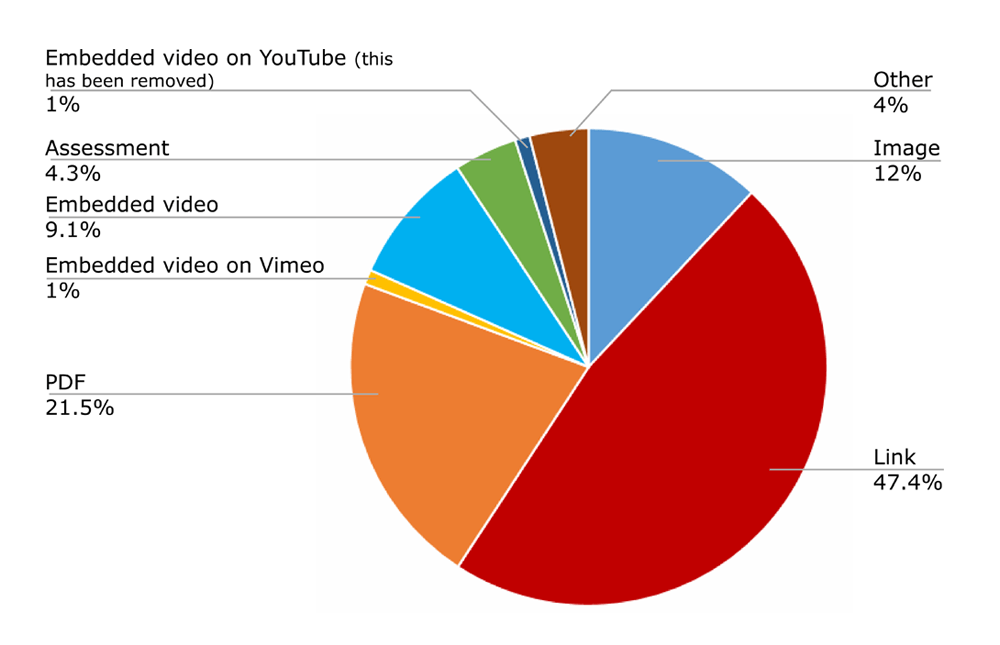
The Chinese librarians who tested these links are “graduates” from Cornell Library’s preservation training workshop, a project generously funded by the Henry Luce Foundation, to build capacity for preserving physical collections and disaster prevention in Chinese libraries.[42] Now in its second round of funding, the program has trained 14 librarians from 10 institutions in mainland China and Taiwan. As a result of this training, half of the participating institutions have developed in-house preservation labs and the “graduates” have trained more than 30 additional librarians through a train-the-trainer workshop, with another one planned for 2017. These librarians were more than willing to give back for the training they had received.
Conclusion
How to determine whether a research library is global-ready? In this article we have stressed the importance of understanding institutional aspirations, partnering locally and abroad, appreciating the cultural assumptions and challenges faced by study abroad and international students, and the value of developing a library-wide capacity to meet needs. A global-ready research library will pivot on the fulcrum of engagement by constantly questioning the effectiveness of its efforts. It is all too easy to become complacent, to point to such things as the development of a LibGuide or orientation session for international students, or the enabling of remote access, the signing of an MOU with an international library, or site visits at libraries abroad. What impact have such efforts had on university programs or the academic success of international students? What concrete measures resulted from the site visits? Are students finding LibGuides useful? Are current strategies sufficiently granular to accommodate differences between students from Asia versus those from Africa? Does remote access actually work in the destination country? Are library services reaching their intended audience at the right time and place? How deeply embedded is the library in institutional planning for internationalization? The Educational Advisory Board report cited earlier recommended 17 high impact practices that were drawn from a number of institutions, e.g., students are more eager to absorb information pre-arrival; self-paced online guides with short videos in which current international students speak about topics and give tips to incoming international students is effective; and the importance of helping them make connections on campus. Research libraries can adopt many of these strategies.[43]
One logical step is to develop key performance indicators that will resonate with the university administration and users alike. Based on these recursive measures, libraries should be prepared to evaluate existing efforts for alignment with emerging needs and priorities.
Some possible measures include:
- Administrators at the university and the department level move the library from afterthought to forethought in international curriculum development and research projects, including dual-degree or overseas-campus programs.
- Faculty and students gain access to resources previously not available to them.
- The library systematically puts in place tailored services to outbound and inbound students. Students have increased awareness of the services and show increased use of them.
- Faculty attribute to libraries a direct impact on better learning and research strategies or decreasing instances of plagiarism.
- Campus units routinely consult the library when developing support services for study abroad and international students.
- Campus units supporting internationalization increase use of library space for formal and informal engagement.
- The library has an active presence in the physical and virtual spaces of study abroad programs and among international student populations.
- International students recommend library services to each other via social media or word of mouth.
- Library training to enhance staff skills in functioning in an international context leads staff to redouble outreach based on an increased level of confidence and awareness of departmental or university international priorities.
- Library staff routinely collaborate with each other to enhance direct engagement with study abroad and international students.
- The library engages in an expanding network both in the U.S. and abroad to share access and expertise.
A global-ready research library is well integrated into the university’s evolving international agenda in teaching, research, and learning, from planning to execution to assessment. At the University of Cincinnati, for instance, Xuemao Wang, the Dean of Libraries, serves on the Provost-appointed Global Advisory Group for China. Under Wang’s leadership, the Library’s vision is to be “the globally engaged, intellectual commons of the university.” The possibilities for deeper engagement are tantalizing when viewed from a collective perspective. One can imagine the development of international services that are modular, co-developed, jointly-staffed, location-responsive, and well integrated into each institution’s operations. Such scenarios can lead to the development of capabilities that are essential but not ordinarily identified as being within the library’s purview. What a compelling future!
- See “Mapping internationalization on US Campuses: 2012,” June 2012, accessed 18 June 2016, https://www.acenet.edu/news-room/Documents/Mapping-Internationalizationon-US-Campuses-2012-full.pdf. ↑
- Graham Elkin, Faiyaz Devjee, and John Farnsworth, “Visualising the ‘Internationalisation’ of Universities,” International Journal of Educational Management 19.4 (2005): 318-329. ↑
- Ibid., 323. ↑
- “Infographics | US Study Abroad Data – Institute of International Education,” accessed 23 June 2016, http://www.iie.org/Research-and-Publications/Open-Doors/Data/Infographics/US-Study-Abroad-Data. ↑
- Ibid. ↑
- See http://www.iie.org/Programs/Generation-Study-Abroad/Commitment-Partners#.V2FXMU32bcs, accessed 17 June 2016 ↑
- See “Fast Facts Open Doors 2015 – Institute of International Education,” 2015, accessed 21 June 2016, http://www.iie.org/~/media/Files/Corporate/Open-Doors/Fast-Facts/Fast-Facts-2015.pdf?la=en. ↑
- Ibid. ↑
- See University of Minnesota Libraries’ Proxy Bookmarklet for Off-Campus Access at https://www.lib.umn.edu/howto/tools/bookmarklet and Cornell University Library’s Passkey at http://labs.library.cornell.edu/passkey. ↑
- “SPEC Kit 309: Library Support for Study Abroad (December 2008),” 2011, accessed 11 Jun. 2016, http://publications.arl.org/Library-Support-Study-Abroad-SPEC-Kit-309/. ↑
- “Article & Book Delivery | Northwestern University Library,” accessed 29 May 2016, http://www.library.northwestern.edu/services/distance-education-study-abroad/article-book-delivery. ↑
- Steven Witt, Laurie Kutner, and Liz Cooper, “Mapping Academic Library Contributions to Campus Internationalization,” College & Research Libraries 76.5 (2015): 587-608, 10.1108/09513540510599644. ↑
- Ibid., 598. ↑
- See sample orientation schedule of the University of Illinois at Urbana–Champaign, accessed 20 June 2016, http://isss.illinois.edu/students/incoming/pre_arrival/grad_orientation.html. ↑
- “Supporting International Students on Campus | EAB,” 2015, accessed 23 June 2016, https://www.eab.com/research-and-insights/student-affairs-forum/studies/2014/supporting-international-students-on-campus. ↑
- See http://www.globalhighered.org/, accessed 15 June 2016. ↑
- See http://shanghai.nyu.edu/. ↑
- See http://www.fuqua.duke.edu/programs/other_programs/mms_seoul_national_university/. ↑
- David L. Di Maria and C.K. Kwai, “Developing an International Student Retention Strategy,” Annual Conference of the Association of International Education Administrators, Washington, D C. Accessed 17 June 2016, http://www.aieaworld.org/assets/docs/Conference_Materials/2014/docstoupload2/di% 20maria% 20kwai% 20presentation.pdf 2014. ↑
- Ibid. ↑
- Ibid. ↑
- Education Advisory Board, “Supporting International Students on Campus: 17 High Impact Practices to Ensure Student Success,” 2015: 22, https://www.eab.com/-/media/EAB/Research-and-Insights/SAF/Studies/2014/Supporting-International-Students-on-Campus/SAF-Supporting-International-Students.pdf. ↑
- Ilka Datig, “What is a Library? International College Students’ Perceptions of Libraries,” (2014) accessed 8 June 2016, http://www.sciencedirect.com/science/article/pii/S0099133314000676. ↑
- Shuqin Jiao, et al. “Chinese Academic Libraries from the Perspective of International Students Studying in China,” The International Information & Library Review 41.1 (2009): 1-11. ↑
- John Hickok, “International Students and Academic Libraries: Initiatives for Success,” 2011, accessed 9 June 2016, https://books.google.com/books?id=KxbYHSIfAaYC&pg=PR8&lpg=PR8&dq=knowing+their+background+first+understanding+prior&source=bl&ots=Aa7sCkqV2m&sig=kLNsZHg8p1NfxnJtHlhnvFszfZs. ↑
- See http://www.uc.edu/international/uc-faculty—staff/faculty-international-projects.html, accessed 21 June 2016. ↑
- K. Bista, “Roles of International Student Advisors: Literature and Practice in American Higher Education,” International Education, 2015, 44(2), 87-101,109, retrieved from http://search.proquest.com.proxy.library.cornell.edu/docview/1674722068?accountid=10267. ↑
- Irene Ke, Kristine Greive, and Porcia Vaughn, “Improving Retention,” American Libraries Magazine, 17 September 2015, accessed 30 May 2016, https://americanlibrariesmagazine.org/2015/09/17/improving-retention-leveraging-collections-student-success/. ↑
- Kayo Denda, “Study Abroad Programs: A Golden Opportunity for Academic Library Engagement,” The Journal of Academic Librarianship, 39. 2 (2013): 155-160, accessed 18 June 2016, http://dx.doi.org/10.1016/j.acalib.2012.08.008.↑
- See http://www.iie.org/Research-and-Publications/Open-Doors/Data/International-Students/Fields-of-Study#.V2aBwk32bcs, accessed 19 June 2016. ↑
- “Fast Facts Open Doors 2015 – Institute of International Education,” 2015, accessed 21 June 2016, http://www.iie.org/~/media/Files/Corporate/Open-Doors/Fast-Facts/Fast-Facts-2015.pdf?la=en. ↑
- Cornell Abroad, 2016. ↑
- Wilkin, John P. The Meaning of the Library: A Cultural History, ed. Alice Crawford, Princeton: Princeton University Press, 2015, 237, accessed 8 June. 2016, https://www.ideals.illinois.edu/bitstream/handle/2142/79053/John%20P.%20Wilkin%20-%20Meanings%20of%20the%20Library%20Today.pdf?sequence=2&isAllowed=y. ↑
- See http://www.clir.org/pubs/reports/pub169/shenetal.pdf. ↑
- See https://overseaschineseconfederation.org/jdlocs/#2. ↑
- See http://www.biodiversitylibrary.org/. ↑
- “Biodiversity Heritage Library – About – Wikispaces,” 2010, accessed 8 June 2016, https://biodivlib.wikispaces.com/. ↑
- Global Biodiversity Heritage Library Coordinating Committee Bylaws, accessed 21 June 2016, http://biodivlib.wikispaces.com/file/view/Global+BHL+Bylaws-approved+06-07-12-1.pdf . ↑
- See http://www.johnson.cornell.edu/Programs/Cornell-Tsinghua-MBA-FMBA. ↑
- See http://guides.library.cornell.edu/Cornell-Tsinghua. ↑
- See http://fin.lib.tsinghua.edu.cn/news/71. ↑
- More description of the grant funded project can be found at: https://www.library.cornell.edu/about/news/press-releases/expanding-preservation-capability-across-china.↑
- Ibid, EAB. ↑
Attribution/NonCommercial 4.0 International License. To view a copy of the license, please see http://creativecommons.org/licenses/by-nc/4.0/.